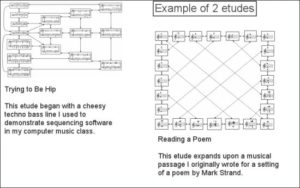



One of my older brothers played a stand-up bass, and unlike my brother I had no formal musical training. The musical notation that my brother could read and the instrument itself were part of a closed, mysterious and privileged society from which I was excluded. But still, I loved to flail away on the thing.
The Piano Etudes project by Jason Freeman, with Akito Van Troyer and Jenny Lin, is a move towards opening the forbidden city of musical composition. The project is based on piano etudes, musical compositions in which the pianist can rearrange connections between some open form pieces. Site visitors are invited to create their own etudes from four short compositions by Jason Freeman. Each etude is transcribed graphically into something that resembles an organizational chart. Each visual component of the chart has a corresponding audio note pattern. The pitch of a note pattern is roughly indicated by the height of a horizontal bar that is part of the graphic. A site user can select graphic elements and arrange them on a time-line to hear the resulting sound piece. Pieces created on the site can be saved and transcribed into musical notation so that pianists can perform pieces created by site visitors.
The Piano Etudes site interface is easy to use. Making the connection between what is possible musically on the site and the visual interface takes a bit of play. But then playing seems to be very much the point of the Piano Etudes project.

Two things that strike me straight off about using visual graphic elements to compose music digitally are remix and re-mediation. The Piano Etudes project invites us to remix the works, to make a new composition from components of the original. Ironically the tradition of open-form musical scores continues in digital mash-ups and other forms of remixing.
Remixing is an admission that all creative product is indebted to other works in some way, and unlike most of the remixing done in the Wild West of popular digital music, in the Piano Etudes site the remixing is done with the authors’ assent and encouragement.
The Piano Etudes project also asks users/composers to re-mediate, to re-write one text in another, completely different medium. Here the musical score becomes visual elements that can be arranged within a rectangular space. The visual mode of composing opens the creative process to those untrained in reading musical scores. That the product – the composition – can then be re-mediated again as musical script, and again re-mediated when performed by a pianist is an amazing expression of digital technology making a creative space.
There are similar spaces for digital composing that do not require formal musical training, the most recognizable being the GarageBand application. The YouTube Symphony Orchestra was competitively constituted by applications/auditions submitted via YouTube. The Pete-Townsend affiliated site and application Method Music (now defunct) came close to offering the kind of creative space for composing music digitally that Piano Etudes makes available. Along the lines of GarageBand and Method music, many of the “opportunities” to create music on the Web are commercial pitches to purchase licensed applications. The free and collaborative nature of the Piano Etudes seems to be quite different.
What makes this project truly wonderful and distinct from other approaches to creating music digitally is that this is a shared creative space. The inherently social nature of the web allows for creative collaboration that dissolves many of the obstacles to creative practices: differences in education, training, language, location, culture and economic status become valuable distinctions among contributors that inform the creative process rather than impede it.
My brother’s stand-up bass offered an opportunity to create something musically, it was a solitary experience, since my playing was dependent on my brother being away from our house. And the product of my flailing away on the bass could be thought of as illegitimate, since I lacked training in music. The Piano Etudes project I feel, values the creative possibilities in us for musical expression. The site also validates those musical expressions by making them available and performative. What is perhaps most valued by the Project Etudes project is play; to discover, to learn and to create through experiences that are enjoyable and interesting – kind of like banging on my brother’s bass fiddle but much more fun, more social and more generative.
——————————–
Special thanks to Turbulence for hosting this web site and including it in their spotlight series and to the American Composers Forum’s Encore Program for supporting several live performances of this work. I developed the web site in collaboration with Akito Van Troyer. Piano Etudes is dedicated to my wife, Leah Epstein. Jason Freeman.